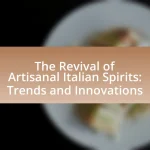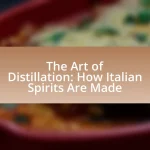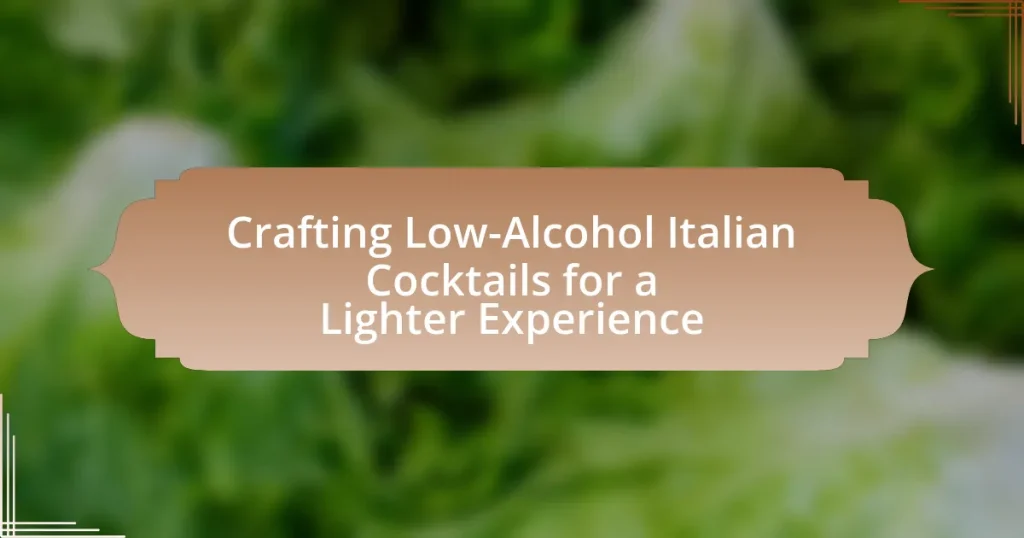Low-alcohol Italian cocktails are beverages characterized by their reduced alcohol content, typically ranging from 5% to 15% ABV, and are crafted using traditional Italian ingredients such as vermouth, aperitifs, and fresh herbs. These cocktails emphasize balanced flavor profiles, allowing for a lighter drinking experience that aligns with the growing trend of moderation in alcohol consumption. The article explores the differences between low-alcohol and traditional cocktails, the key ingredients and techniques for crafting them, and the health benefits associated with their consumption. Additionally, it highlights popular recipes and innovative variations, showcasing how seasonal ingredients and unique flavor combinations can enhance these refreshing drinks.

What are Low-Alcohol Italian Cocktails?
Low-alcohol Italian cocktails are beverages that typically contain lower alcohol content than standard cocktails, often featuring Italian ingredients and flavors. These cocktails are designed to provide a lighter drinking experience while still delivering the essence of Italian mixology, utilizing ingredients such as vermouth, aperitifs like Aperol or Campari, and fresh herbs or citrus. The trend towards low-alcohol cocktails aligns with a growing consumer preference for moderation in alcohol consumption, as evidenced by the increasing popularity of drinks like the Spritz, which combines prosecco, soda water, and a low-alcohol aperitif.
How do Low-Alcohol Italian Cocktails differ from traditional cocktails?
Low-alcohol Italian cocktails differ from traditional cocktails primarily in their reduced alcohol content, typically ranging from 5% to 15% ABV compared to the 15% to 30% ABV found in many classic cocktails. This lower alcohol level allows for a more balanced flavor profile, emphasizing ingredients like fresh herbs, fruits, and bitters, which are often used in Italian mixology. For example, drinks like the Spritz or Negroni Sbagliato highlight the use of lighter aperitifs and sparkling wines, creating a refreshing experience that is less intoxicating. This approach aligns with the Italian tradition of enjoying drinks in moderation, often as part of a social experience rather than solely for intoxication.
What ingredients are typically used in Low-Alcohol Italian Cocktails?
Low-alcohol Italian cocktails typically use ingredients such as vermouth, aperitivo, soda water, fresh citrus juices, and herbal infusions. Vermouth, a fortified wine, serves as a base, while aperitivos like Aperol or Campari add flavor and color. Soda water is often included to dilute the alcohol content, and fresh citrus juices enhance the drink’s freshness. Herbal infusions, such as basil or rosemary, provide aromatic complexity, making these cocktails both flavorful and refreshing while maintaining a lower alcohol level.
How do the flavor profiles of Low-Alcohol Italian Cocktails compare to regular cocktails?
Low-alcohol Italian cocktails typically exhibit lighter, more nuanced flavor profiles compared to regular cocktails, which often feature bolder and more intense flavors due to higher alcohol content. The lower alcohol content in these Italian cocktails allows for a greater emphasis on the freshness of ingredients, such as herbs, citrus, and bitters, resulting in a more balanced and refreshing taste. For instance, cocktails like the Spritz highlight the use of prosecco and aperitifs, which provide a crisp and aromatic experience, contrasting with the heavier, spirit-forward nature of traditional cocktails like martinis or old fashioneds. This distinction is supported by the trend towards lighter drinking options, as seen in the growing popularity of low-alcohol beverages in the cocktail industry, reflecting a shift in consumer preferences towards moderation and flavor complexity.
Why are Low-Alcohol Italian Cocktails gaining popularity?
Low-alcohol Italian cocktails are gaining popularity due to a growing consumer preference for healthier drinking options and the rise of mindful drinking culture. This trend is supported by research indicating that 66% of consumers are seeking lower-alcohol beverages as part of a healthier lifestyle. Additionally, the unique flavors and artisanal quality of Italian cocktails, often made with fresh ingredients and traditional recipes, appeal to those looking for sophisticated yet lighter drinking experiences. The combination of health consciousness and the desire for quality has made low-alcohol Italian cocktails a favored choice among modern drinkers.
What health benefits are associated with consuming Low-Alcohol cocktails?
Consuming low-alcohol cocktails can offer several health benefits, including reduced calorie intake and lower risk of alcohol-related health issues. These cocktails typically contain fewer calories than their high-alcohol counterparts, which can aid in weight management. Additionally, lower alcohol content can lead to decreased risks of liver disease, cardiovascular problems, and alcohol dependency, as supported by research indicating that moderate alcohol consumption is associated with a lower risk of certain health issues compared to heavy drinking.
How do cultural trends influence the rise of Low-Alcohol Italian Cocktails?
Cultural trends significantly influence the rise of low-alcohol Italian cocktails by promoting health-conscious lifestyles and social drinking experiences. The increasing awareness of health and wellness has led consumers to seek beverages that offer lower alcohol content while still providing flavor and enjoyment. For instance, the Italian aperitivo culture emphasizes moderation and social interaction, encouraging the consumption of lighter drinks that complement meals rather than overpower them. Additionally, the global trend towards mindful drinking, supported by statistics showing a rise in non-alcoholic and low-alcohol beverage sales, further validates this shift. According to a report by IWSR, the low-alcohol segment is projected to grow by 31% by 2024, reflecting changing consumer preferences that favor low-alcohol options.

What are the key components of crafting Low-Alcohol Italian Cocktails?
The key components of crafting Low-Alcohol Italian Cocktails include the use of low-alcohol spirits, fresh ingredients, and balanced flavors. Low-alcohol spirits, such as vermouth or aperitifs like Aperol and Campari, typically contain around 15-25% alcohol by volume, making them ideal for lighter cocktails. Fresh ingredients, including herbs, fruits, and citrus, enhance the drink’s flavor profile while keeping it refreshing. Additionally, achieving a balance between sweetness, bitterness, and acidity is crucial, as it ensures a harmonious taste that complements the low-alcohol base. This approach aligns with the Italian tradition of aperitivo, which emphasizes moderation and enjoyment in social settings.
How do you select the right base spirits for Low-Alcohol Italian Cocktails?
To select the right base spirits for low-alcohol Italian cocktails, prioritize spirits with lower alcohol content, such as vermouth, amaro, or aperitivo. These spirits typically range from 15% to 25% ABV, making them suitable for crafting lighter cocktails while still providing complex flavors. For example, vermouth adds herbal notes, while amaro contributes bitterness, enhancing the overall taste profile without overwhelming the drink. Additionally, using fresh ingredients like citrus or herbs can further balance the flavors, ensuring a refreshing experience.
What role do vermouths and aperitifs play in these cocktails?
Vermouths and aperitifs serve as essential flavor components in low-alcohol Italian cocktails, enhancing complexity and balance. These fortified wines and herbal infusions contribute aromatic profiles and a touch of bitterness, which are crucial for creating a well-rounded drink. For instance, vermouths often contain a blend of botanicals that add depth, while aperitifs like Aperol or Campari introduce a refreshing, slightly bitter taste that complements other ingredients. This combination not only elevates the overall drinking experience but also aligns with the Italian tradition of enjoying lighter, more sessionable cocktails.
How can fresh ingredients enhance the quality of Low-Alcohol Italian Cocktails?
Fresh ingredients significantly enhance the quality of Low-Alcohol Italian Cocktails by providing vibrant flavors, improved aromas, and essential nutrients. The use of fresh herbs, fruits, and vegetables elevates the taste profile, making cocktails more refreshing and balanced. For instance, fresh basil or mint can add aromatic complexity, while freshly squeezed citrus juices contribute brightness and acidity, which are crucial for a well-rounded drink. Additionally, studies show that fresh ingredients can contain higher levels of antioxidants and vitamins, which not only improve the health aspect of cocktails but also enhance the overall drinking experience.
What techniques are essential for crafting Low-Alcohol Italian Cocktails?
Essential techniques for crafting Low-Alcohol Italian Cocktails include using high-quality, low-alcohol spirits, incorporating fresh ingredients, and balancing flavors with bitters and citrus. High-quality, low-alcohol spirits like vermouth or aperitivo provide depth without overwhelming alcohol content. Fresh ingredients, such as herbs and fruits, enhance flavor profiles while keeping the drink light. Additionally, bitters and citrus add complexity and brightness, making the cocktail more enjoyable. These techniques ensure a flavorful experience while maintaining a lower alcohol level, aligning with the trend of lighter drinking options.
How does the method of mixing affect the final drink?
The method of mixing significantly influences the final drink by affecting its texture, dilution, and flavor integration. For instance, shaking a cocktail incorporates air, resulting in a frothy texture and a more diluted drink due to the ice melting, which can enhance the drink’s overall flavor profile. Conversely, stirring a cocktail maintains a smoother texture and less dilution, preserving the integrity of the ingredients. Research indicates that the method of mixing can alter the perception of taste; a study published in the Journal of Food Science found that different mixing techniques can change the aroma release and mouthfeel, ultimately impacting the drink’s enjoyment.
What garnishing techniques can elevate Low-Alcohol Italian Cocktails?
Garnishing techniques that can elevate Low-Alcohol Italian Cocktails include using fresh herbs, citrus peels, and edible flowers. Fresh herbs like basil or mint add aromatic complexity, enhancing the cocktail’s flavor profile. Citrus peels, such as lemon or orange, provide a zesty aroma and visual appeal, while edible flowers like nasturtiums or violets introduce a vibrant color and delicate taste. These garnishes not only enhance the aesthetic but also contribute to the overall sensory experience, making the cocktails more enjoyable.

What are some popular Low-Alcohol Italian Cocktail recipes?
Some popular low-alcohol Italian cocktail recipes include the Spritz, Negroni Sbagliato, and Americano. The Spritz, traditionally made with Prosecco, Aperol, and soda water, has a lower alcohol content due to the dilution from soda. The Negroni Sbagliato substitutes gin with sparkling wine, reducing the overall alcohol level while maintaining the cocktail’s signature flavor. The Americano, composed of Campari, sweet vermouth, and soda water, is another classic that offers a refreshing taste with lower alcohol content. These cocktails are well-regarded for their balance of flavor and lighter drinking experience.
How do you prepare a classic Spritz with a low-alcohol twist?
To prepare a classic Spritz with a low-alcohol twist, combine 2 ounces of low-alcohol aperitif, such as a non-alcoholic vermouth or a low-alcohol aperitivo, with 3 ounces of sparkling water and 1 ounce of prosecco. This mixture maintains the refreshing qualities of a traditional Spritz while reducing the overall alcohol content. The use of low-alcohol aperitifs, which typically contain around 0.5% to 8% alcohol by volume, allows for a lighter drinking experience without sacrificing flavor.
What variations can be made to the traditional Spritz recipe?
Variations to the traditional Spritz recipe include using different base spirits, such as gin, vodka, or flavored liqueurs like Aperol or Campari, instead of the classic Prosecco. Additionally, one can experiment with various bitters or mixers, such as elderflower tonic or fruit juices, to create unique flavor profiles. For instance, a Gin Spritz incorporates gin and elderflower tonic, while a Campari Spritz uses Campari for a more bitter taste. These adaptations maintain the refreshing essence of the original while offering diverse taste experiences.
What are the best pairings for a Low-Alcohol Spritz?
The best pairings for a Low-Alcohol Spritz include light appetizers, fresh salads, and seafood dishes. These food options complement the refreshing and crisp nature of the spritz, enhancing the overall dining experience. For instance, a classic pairing is a plate of bruschetta topped with tomatoes and basil, which balances the drink’s acidity. Additionally, a citrusy arugula salad can elevate the flavors of the spritz, while grilled shrimp or calamari provide a savory contrast that works well with the drink’s lightness.
What are some innovative Low-Alcohol Italian Cocktail recipes to try?
Some innovative low-alcohol Italian cocktail recipes to try include the Spritz Bianco, which combines white wine, soda water, and a splash of elderflower liqueur, creating a refreshing drink with lower alcohol content. Another option is the Negroni Sbagliato, made with Prosecco instead of gin, offering a lighter twist on the classic Negroni while maintaining its signature flavor profile. Additionally, the Aperol Spritz, featuring Aperol, Prosecco, and soda water, remains a popular choice for its vibrant color and balanced taste, all while being lower in alcohol than traditional cocktails. These recipes highlight the trend of crafting lighter Italian cocktails that still deliver on flavor and experience.
How can you incorporate seasonal ingredients into Low-Alcohol cocktails?
Incorporating seasonal ingredients into low-alcohol cocktails can be achieved by selecting fruits, herbs, and vegetables that are at their peak during specific times of the year. For example, using fresh strawberries in spring, peaches in summer, apples in fall, and citrus fruits in winter enhances flavor and freshness. Seasonal ingredients not only provide vibrant tastes but also contribute to sustainability by reducing the carbon footprint associated with transporting out-of-season produce. Additionally, utilizing local farmers’ markets can ensure the ingredients are fresh and in season, further elevating the quality of the cocktails.
What unique flavor combinations work well in Low-Alcohol Italian Cocktails?
Unique flavor combinations that work well in Low-Alcohol Italian Cocktails include Aperol with grapefruit and rosemary, Campari with blood orange and tonic, and vermouth with elderflower and lemon. These combinations leverage the herbal and citrus notes typical of Italian spirits, enhancing the overall drinking experience while maintaining a lower alcohol content. For instance, Aperol’s sweetness pairs beautifully with the tartness of grapefruit, while rosemary adds an aromatic depth, making it a refreshing choice. Similarly, Campari’s bitterness is balanced by the sweetness of blood orange, creating a vibrant cocktail that is both complex and enjoyable.
What tips can help you craft the perfect Low-Alcohol Italian Cocktail?
To craft the perfect Low-Alcohol Italian Cocktail, focus on using high-quality ingredients and balancing flavors. Start with a base of low-alcohol spirits like Aperol or Lillet, which typically contain around 11-17% alcohol by volume, compared to standard spirits. Incorporate fresh herbs, citrus juices, and soda water to enhance flavor without adding significant alcohol content. For instance, a Spritz combines Aperol, prosecco, and soda water, creating a refreshing drink with lower alcohol levels. Additionally, using fresh ingredients like basil or mint can elevate the cocktail’s taste profile while keeping it light.
How can you balance flavors in Low-Alcohol cocktails effectively?
To balance flavors in low-alcohol cocktails effectively, use a combination of sweet, sour, and bitter elements to create harmony. For instance, incorporating fresh citrus juices can provide acidity, while herbal liqueurs or bitters can add complexity and depth. Additionally, using flavored syrups or fresh fruits can enhance sweetness without increasing alcohol content. Research indicates that a balanced cocktail typically contains a ratio of one part sweet, one part sour, and one part bitter, which helps to achieve a well-rounded flavor profile.
What common mistakes should be avoided when crafting these cocktails?
Common mistakes to avoid when crafting low-alcohol Italian cocktails include using overly sweet mixers, neglecting balance in flavors, and failing to properly chill ingredients. Overly sweet mixers can overpower the delicate flavors typical of Italian cocktails, leading to an unbalanced drink. Neglecting flavor balance can result in cocktails that are either too bitter or too sour, detracting from the intended experience. Properly chilling ingredients is crucial, as serving cocktails at the right temperature enhances their refreshing qualities. These mistakes can diminish the overall enjoyment and authenticity of the cocktail experience.










